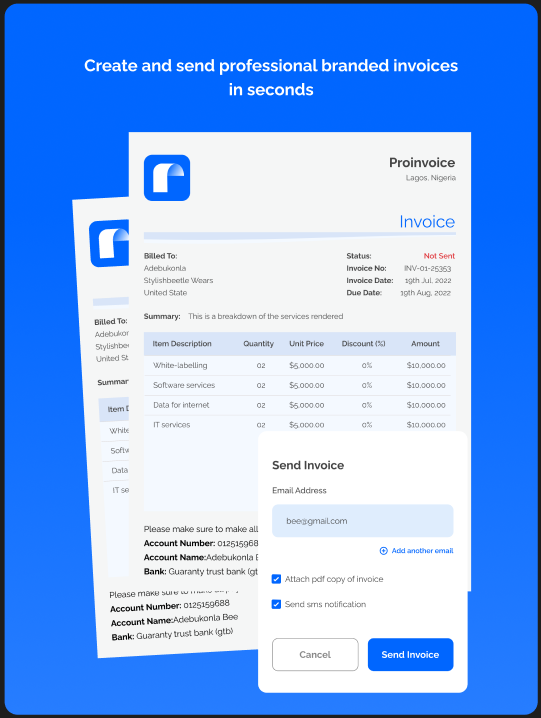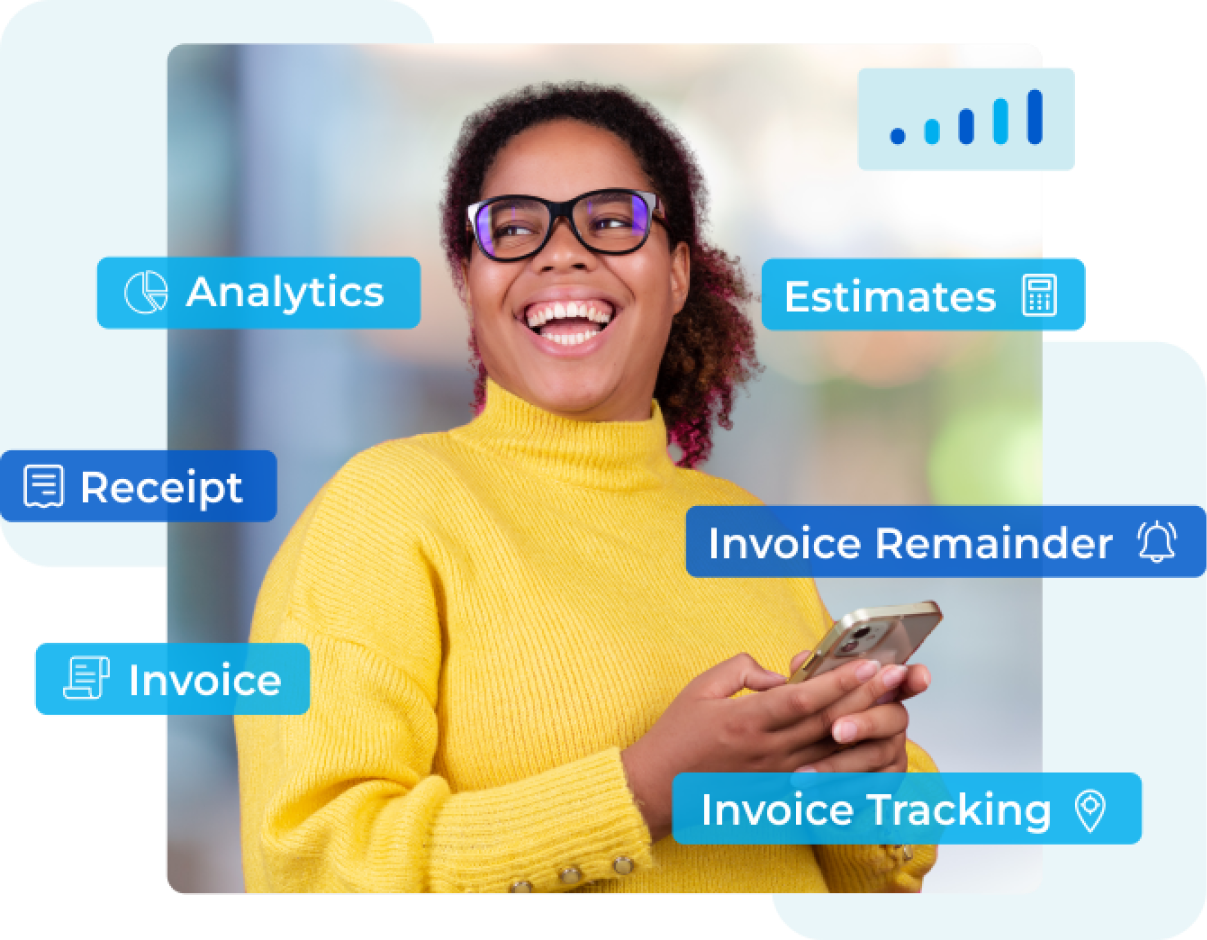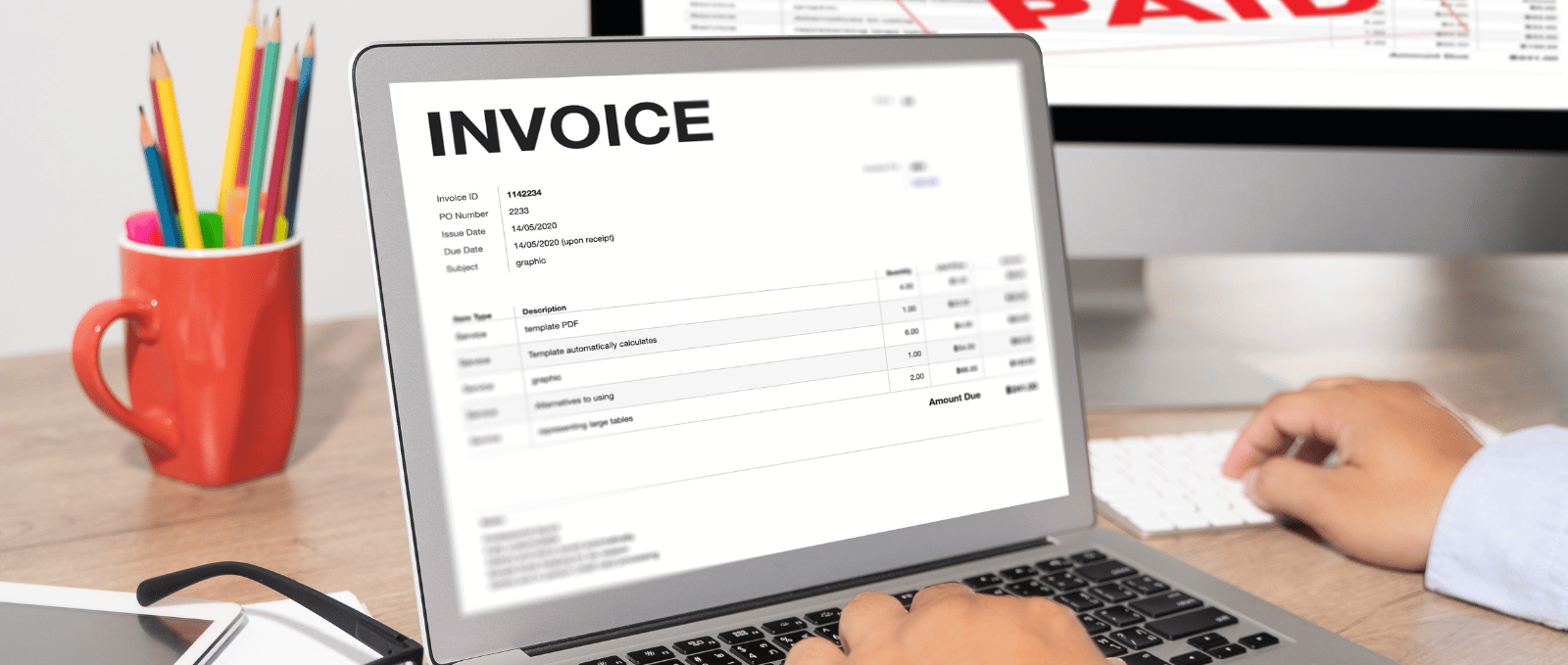How Small Businesses Can Save Money by Going Paperless – ProInvoice: Running a small business means constantly seeking ways to reduce costs without sacrificing quality or professionalism. Yet many entrepreneurs overlook one of the most significant opportunities sitting right under their noses: eliminating paper-based processes. The shift to paperless operations isn’t merely an environmental choice—it’s a strategic financial decision that delivers measurable savings and operational improvements from day one.
Click to download the Proinvoice mobile app now to manage your invoices anytime, anywhere with ease!
Uncovering the True Cost of Paper Operations
Most business owners dramatically underestimate what paper-based systems actually cost. Beyond the obvious expense of buying printer paper and ink cartridges, paper operations drain resources through multiple hidden channels that add up to substantial annual costs.
Think about a typical small business processing 100 invoices each month. Every single invoice demands paper, envelopes, postage stamps, toner or ink, plus employee time for printing, folding, stuffing envelopes, addressing, and trips to the mailbox. Industry studies reveal that processing one paper invoice costs between $15 and $40 when you factor in all expenses. That means our example business spends $1,500 to $4,000 monthly—translating to $18,000 to $48,000 annually—just on invoice processing alone.
Storage costs represent another drain that rarely gets calculated. Filing cabinets aren’t free, and neither is the floor space they occupy. A standard four-drawer filing cabinet takes up 9 square feet, and commercial office space typically runs $20-50 per square foot yearly in most markets. If your business maintains five filing cabinets for financial documents, you’re spending $900-2,250 each year simply warehousing paper.
Time waste creates yet another hidden expense. According to workplace efficiency research, employees spend an average of 18 minutes hunting for each document they need. When your team searches for financial records just three times daily, that’s nearly an hour of lost productivity every single day—essentially having one full-time employee spend a quarter of their work hours looking for papers instead of generating revenue.
Errors from manual data entry compound these problems. Mistakes lead to incorrect payments, missed early payment discounts, duplicate charges, and strained vendor relationships. Research shows manual data entry carries error rates between 1-4%, meaning for every 100 invoices your team processes, one to four contain mistakes requiring additional time and resources to catch and correct.
Immediate Financial Benefits of Digital Invoicing
Switching to digital invoicing through platforms like ProInvoice creates instant, measurable cost reductions across multiple areas of your business operations.
Material Costs Vanish – Digital invoices eliminate the need for paper, envelopes, stamps, and printer supplies entirely. A business sending 100 invoices monthly saves roughly $200-400 on these direct materials alone, totaling $2,400-4,800 per year. This represents pure cost elimination with zero offsetting expenses.
Labor Costs Drop Dramatically – Creating digital invoices takes a fraction of the time required for paper processes. Tasks that once involved printing, folding, addressing, and mailing now happen with a few clicks. Businesses typically slash invoice processing time by 60-80%, freeing employees to focus on activities that drive revenue rather than administrative busywork. When an employee currently spends 10 hours weekly on invoice tasks, going paperless recovers 6-8 hours that can shift toward sales, customer service, or strategic planning.
Payment Cycles Accelerate – Perhaps the most powerful financial impact comes from faster payment collection. Digital invoices arrive instantly, removing mail delivery delays entirely. Automated payment reminders ensure clients never overlook outstanding invoices. Combined, these features typically shrink payment cycles by 15-30 days. For a small business carrying $50,000 in monthly receivables, collecting payment 20 days earlier improves cash flow by approximately $33,000—capital you can reinvest in growth, use for supplier discounts, or deploy to reduce credit line dependence.
Storage Expenses Disappear – Digital records need zero physical storage space. Those five filing cabinets mentioned earlier can be removed, freeing valuable office space for productive uses or potentially enabling downsizing to cheaper facilities. Digital storage proves infinitely more efficient—thousands of invoices consume mere megabytes of digital space costing pennies, versus cubic feet of physical space costing dollars monthly.
Error Rates Plummet – Automated calculations and data entry eliminate the human mistakes that plague manual systems. ProInvoice automatically calculates totals, taxes, and discounts with perfect accuracy every single time. This precision prevents costly errors, reduces dispute resolution time, and maintains professional credibility with clients.
Stay organized as you grow. Use ProInvoice to manage billing and client relationships with ease.
Expanding Beyond Invoicing: Full Paperless Operations
While invoicing offers the most impactful starting point, extending paperless practices across all business documentation multiplies your savings and efficiency gains.
Digital Contracts and Agreements – Electronic signature platforms let businesses create, send, and execute contracts entirely digitally. This approach eliminates printing costs, speeds up deal closing, and builds searchable archives of all agreements. Businesses report cutting contract cycles from weeks to mere days through digital processes, accelerating revenue recognition while improving client satisfaction.
Paperless Expense Management – Mobile applications allow employees to photograph receipts and submit expense reports digitally, removing paper receipt management and manual report processing. Finance teams can review and approve expenses from anywhere, speeding up reimbursements while maintaining complete audit trails.
Digital Record Keeping – Scanning and digitizing historical records creates searchable databases that transform document retrieval from a time-consuming frustration into an instant search. Optical character recognition (OCR) technology makes scanned documents fully searchable, enabling employees to locate specific information in seconds instead of minutes or hours.
Electronic Communications – Email and messaging platforms have largely replaced paper memos and letters, yet many businesses still print emails or create paper copies of digital communications. Committing fully to digital communications eliminates these hybrid inefficiencies and ensures all team members access the most current information simultaneously.
Strategic Implementation for Maximum Returns
Successfully transitioning to paperless operations requires thoughtful planning and systematic execution. Following proven strategies ensures smooth adoption while maximizing financial benefits.
Begin with High-Impact Processes – Launch your paperless journey with processes offering the greatest financial returns. Invoicing typically delivers the highest-impact results, making platforms like ProInvoice ideal for initial implementation. Early wins build momentum and demonstrate value to skeptical team members.
Select the Right Tools – Choose platforms designed specifically for small businesses, featuring intuitive interfaces requiring minimal training. Mobile accessibility ensures team members maintain productivity regardless of location, supporting the flexible work arrangements increasingly defining modern business operations.
Design Digital-First Workflows – Redesign business processes around digital systems rather than simply digitizing existing paper workflows. This approach unlocks greater efficiencies by eliminating steps that existed solely to accommodate paper limitations. Instead of printing invoices for manager approval before sending, implement digital approval workflows happening entirely within your invoicing platform.
Train Your Team Thoroughly – Resistance to change often stems from unfamiliarity and discomfort with new tools. Comprehensive training ensures all team members understand new systems and feel confident using them. Emphasize how paperless operations make jobs easier and more enjoyable by eliminating tedious manual tasks.
Communicate with Clients and Vendors – Inform clients and vendors about your transition to paperless operations, emphasizing benefits they’ll experience through faster, more accurate transactions. Most business partners appreciate professional, efficient systems and will support your transition. Offer options for those with specific preferences, demonstrating flexibility while encouraging adoption of superior digital methods.
Track and Celebrate Results – Monitor key metrics like processing times, error rates, and cost savings to quantify paperless operations’ impact. Share these results with your team, celebrating successes and identifying areas for continued improvement. Visible results motivate continued commitment to paperless processes.
Stay organized as you grow. Use ProInvoice to manage billing and client relationships with ease.
Environmental Benefits That Carry Economic Value
While financial savings drive most business decisions, the environmental benefits of going paperless increasingly carry tangible economic value worth considering.
Corporate social responsibility matters to customers, particularly younger generations who prefer conducting business with environmentally conscious companies. Demonstrating commitment to sustainability through paperless operations enhances brand reputation and can become a competitive differentiator in crowded markets.
Many business-to-business clients now incorporate environmental criteria into vendor selection processes. Companies with strong sustainability practices gain advantages when competing for contracts, especially with larger corporations maintaining formal supplier diversity and sustainability programs.
Additionally, some jurisdictions offer tax incentives or regulatory benefits for businesses implementing environmentally friendly practices. While these incentives vary by location and industry, they represent potential financial benefits beyond the direct cost savings of going paperless.
Addressing Common Concerns and Hesitations
Despite clear advantages, some business owners hesitate to embrace paperless operations. Addressing these concerns directly helps overcome resistance and unlock the full potential of digital transformation.
“My clients prefer paper invoices.” – While some clients initially express preference for paper, this usually reflects habit rather than genuine necessity. Offering both options during a transition period accommodates preferences, yet most clients quickly appreciate the convenience and professionalism of digital invoices. Many businesses discover that after initial resistance, clients actually prefer digital systems for easier tracking and faster processing.
“Digital systems aren’t secure.” – Modern cloud-based platforms employ bank-level encryption and security measures far exceeding the security of paper documents, which can be lost, stolen, or damaged easily. Digital systems include automated backups, ensuring business continuity even when devices are lost or damaged. Access controls ensure only authorized personnel view sensitive financial information.
“I need paper records for tax purposes.” – Tax authorities in the United States fully accept digital records, provided they’re maintained in organized, retrievable formats. Quality invoicing platforms automatically create audit trails and maintain records in formats satisfying tax compliance requirements. Digital records often prove superior for tax purposes because they’re searchable, sortable, and impossible to lose or damage through physical deterioration.
“The transition will disrupt operations too much.” – Modern platforms are designed for rapid deployment with minimal disruption. Many businesses successfully transition during a single slow week, while others prefer gradual rollouts phasing in paperless processes over several months. The key lies in choosing user-friendly tools requiring minimal training and integrating smoothly with existing systems.
“What happens if computers crash or internet goes down?” – Cloud-based systems store data on secure remote servers with multiple redundancies, making data loss virtually impossible. Internet outages may temporarily prevent access, but data remains safe and accessible once connectivity restores. This protection dramatically exceeds paper systems, where a single fire or flood can destroy irreplaceable records forever.
Calculating Your Specific Savings Potential
Every business operates differently, but you can estimate potential savings using straightforward calculations tailored to your situation.
Begin by counting monthly invoices and other documents currently processed on paper. Multiply this number by $15-40 to estimate current processing costs. Add material costs including paper, ink, postage, and envelopes, plus storage costs calculated by multiplying occupied square footage by your cost per square foot.
Calculate employee time spent on paper-related tasks—creating, processing, filing, and retrieving documents. Multiply these hours by average hourly wages (including benefits) to quantify labor costs attributable to paper processes.
Estimate the value of improved cash flow from faster payment cycles. If you typically carry $X in outstanding receivables and can reduce payment cycles by Y days, the improved cash position equals (X × Y) ÷ 30. This freed capital can reduce debt service costs or fund growth initiatives without requiring external financing.
For most small businesses, total annual savings from going paperless range from $10,000 to $50,000, depending on transaction volumes and current efficiency levels. These savings flow directly to your bottom line, improving profitability without requiring additional sales or customers.
Gaining Competitive Edge Through Early Adoption
Businesses embracing paperless operations gain competitive advantages extending well beyond mere cost savings. Professional, streamlined processes improve client experiences, enhancing satisfaction and loyalty. Faster, more accurate invoicing positions your business as modern and efficient, differentiating you from competitors still using outdated paper systems.
Paperless operations support business scalability in ways paper systems simply cannot match. Digital systems handle 10 invoices or 10,000 with equal ease, whereas paper-based processes require proportionally more resources as volume increases. This scalability ensures your operational infrastructure supports growth rather than constraining it.
Remote and distributed teams, increasingly common in modern business, function seamlessly with digital systems but struggle with paper-based processes requiring physical presence for document access. Going paperless future-proofs your business for evolving work arrangements and expanded talent access.
Making Your First Move Today
Transitioning to paperless operations might seem daunting initially, but the journey begins with a single simple step. Modern platforms make adoption surprisingly straightforward, with many businesses successfully implementing digital invoicing in under an hour.
Start by exploring free tools that let you create your first digital invoice without any commitment or cost. Experience firsthand how quickly and professionally you can generate invoices that look better than anything you’ve created on paper. This hands-on trial demonstrates the value proposition while requiring zero investment of time or money.
When you’re ready to unlock comprehensive features like automated reminders, payment tracking, and financial analytics, full registration takes just minutes. There’s no lengthy setup process, no complicated installation—just straightforward account creation respecting your time and getting you invoicing immediately.
Seizing the Opportunity Now
The money your business saves by going paperless can fund growth initiatives, boost profitability, or provide financial cushion against unexpected challenges. Every month you delay represents lost savings and missed opportunities to strengthen your financial position. The question isn’t whether paperless operations make financial sense—the data clearly demonstrates they do—but rather how quickly you’ll capture these benefits for your business.
Your paperless future stands ready to begin right now. The tools exist, the benefits are proven, and the path forward is clear. Make today the day you stop letting paper processes drain your resources and start capturing the substantial savings that paperless operations deliver. Transform your business operations, improve your cash flow, and position your company for sustainable growth in an increasingly digital marketplace. The opportunity is here. The time is now. Your more profitable, efficient future awaits.






![Best AI Invoice Automation Software for Small Business USA [2025]](https://proinvoice.co/wp-content/uploads/2025/08/ProInvoice-AI-Invoice.webp)








